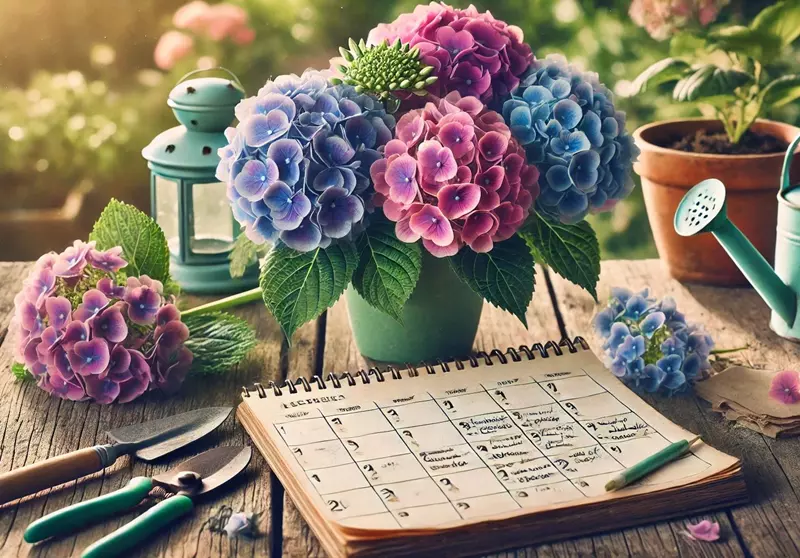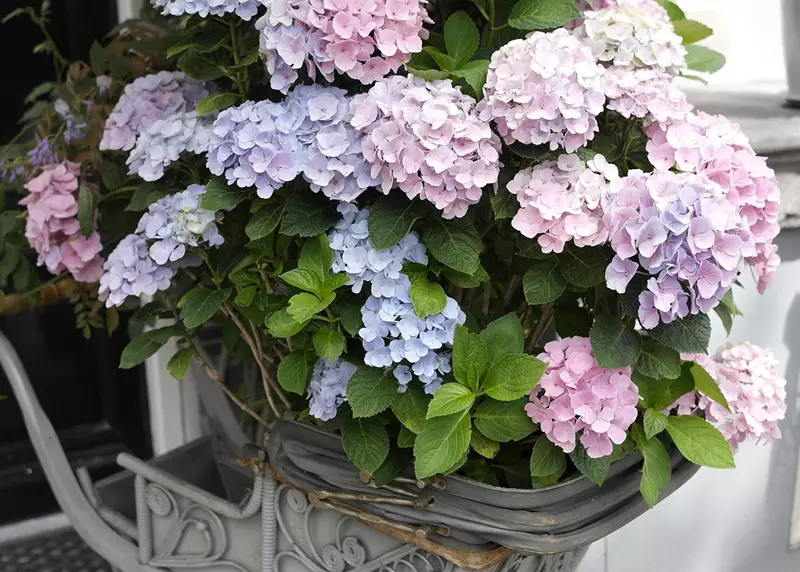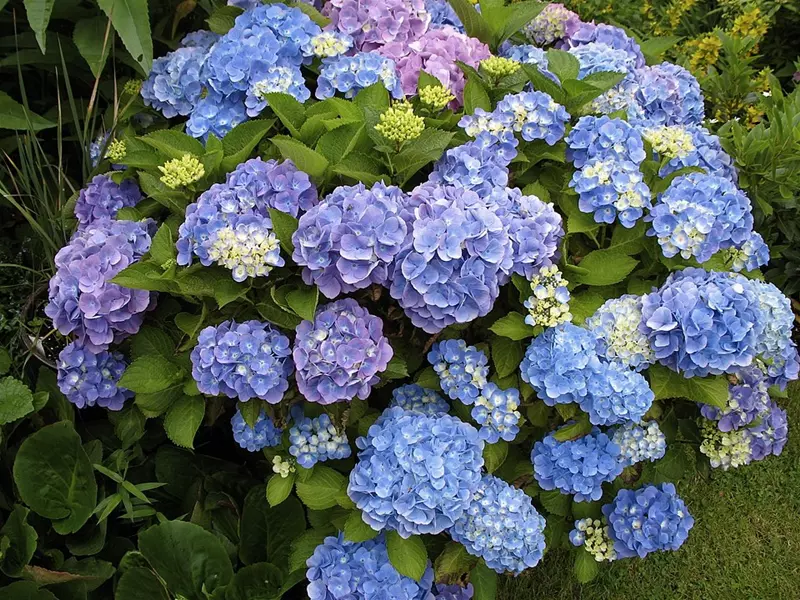Table of Contents
🌸 How to Plant and Care for Hydrangeas (Step-by-Step Guide)
- 📍 Choose the Ideal Location: Select a spot with morning sun and afternoon shade, protected from wind and extreme temperatures.
- 🪴 Prepare the Soil: Ensure well-draining soil rich in organic matter. Test and adjust pH to influence bloom colour (acidic = blue, alkaline = pink).
- 📅 Plant at the Right Time: Early spring or autumn is best, when temperatures are moderate and rainfall helps root establishment.
- 💧 Hydrate the Plant: Before planting, submerge the root ball in water for 1–2 minutes until fully saturated.
- 🕳️ Dig the Hole: Make it twice as wide as the root ball and just as deep. Backfill with amended soil and firm gently.
- 🌿 Water Deeply: After planting, water generously and apply mulch to retain moisture and regulate soil temperature.
- 🍂 Maintain Proper Care: Water regularly, fertilise in spring and summer with a balanced mix, and prune based on species-specific needs.
- 🛡️ Prevent Issues: Monitor for pests and diseases. Ensure airflow, avoid overwatering, and apply organic treatments if needed.
Hydrangeas are popular flowering shrubs known for their stunning blooms and versatility in gardens. Whether you're planting them as standalone features or as part of a larger landscape, understanding the correct planting and care techniques is essential to ensure healthy growth and vibrant flowers.
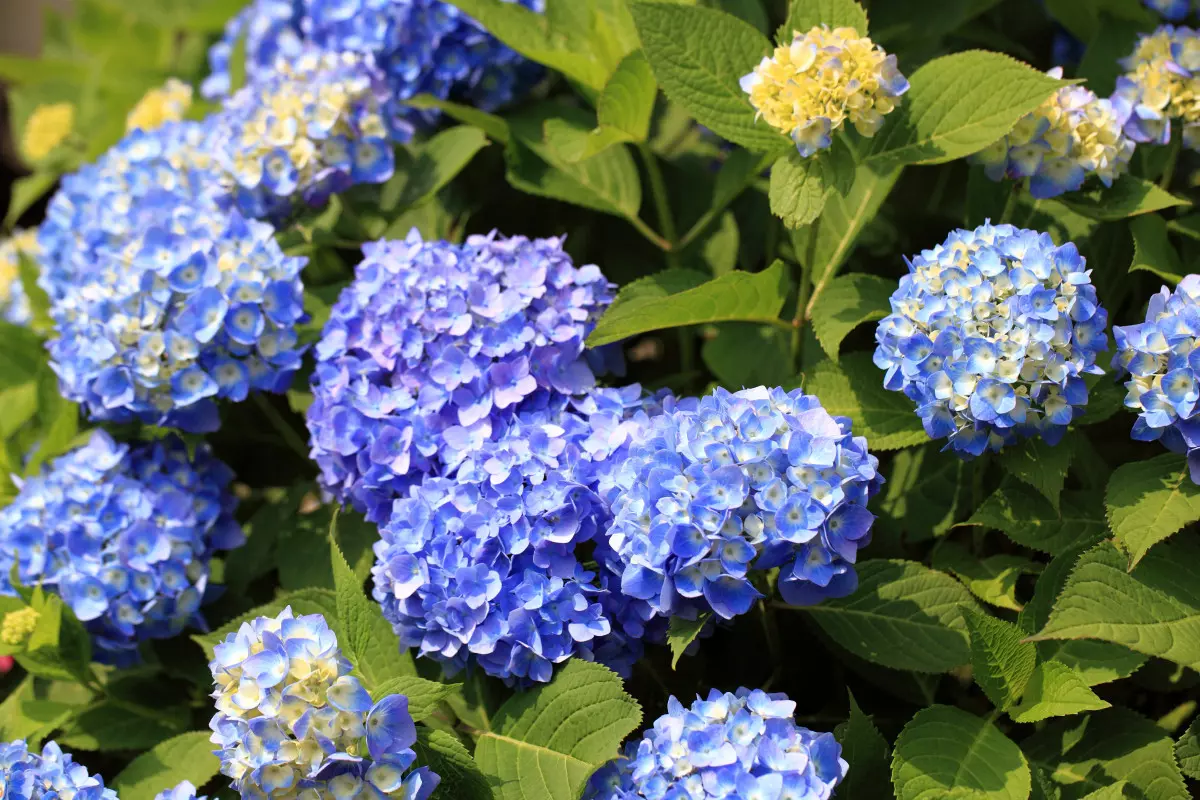 Lilac-blue hydrangeas in full summer bloom, showcasing their lush green leaves and healthy growth. These vibrant flowers highlight the importance of proper soil preparation, watering, and seasonal care for thriving hydrangeas. - Source: pxhere.com; License: CC0 1.0
Lilac-blue hydrangeas in full summer bloom, showcasing their lush green leaves and healthy growth. These vibrant flowers highlight the importance of proper soil preparation, watering, and seasonal care for thriving hydrangeas. - Source: pxhere.com; License: CC0 1.0
Optimal Site Selection for Hydrangeas
Selecting the appropriate site for planting hydrangeas is crucial to ensure their healthy growth and vibrant blooms. This guide delves into the key factors to consider when choosing the perfect location for your hydrangeas.
Light Requirements
Hydrangeas' light needs vary among species:
- Partial Shade: Most hydrangeas thrive in locations that receive morning sun followed by afternoon shade. This exposure protects them from intense midday heat, reducing the risk of wilting.
- Full Sun Tolerance: Certain species, such as Hydrangea paniculata, can tolerate full sun, provided they receive adequate moisture. In hotter climates, strategic placement and proper watering are essential. If you live in a high-temperature region, check out these expert tips for growing hydrangeas in extreme heat.
- Deep Shade: Hydrangeas generally do not perform well in deep shade. If grass struggles to grow in a particular area due to shade, hydrangeas are unlikely to thrive there.

Soil Conditions
The soil plays a pivotal role in the health of hydrangeas:
- Well-Draining Soil: Hydrangeas prefer moist, well-draining soils rich in organic matter. Poor drainage can lead to root rot and other health issues.
- Soil pH: The pH level can influence bloom colour in some hydrangea species. Acidic soils (pH below 6) tend to produce blue flowers, while alkaline soils (pH above 7) result in pink flowers. Adjusting soil pH can help achieve the desired bloom colour.
- Organic Matter: Incorporating compost or well-rotted manure enhances soil fertility and structure, promoting robust growth.
Enhancing Soil Health with Diatomaceous Earth
Creating the ideal soil environment for hydrangeas involves more than just selecting the right planting location. One effective method for improving soil conditions is incorporating diatomaceous earth for hydrangeas into the soil. This natural substance enhances drainage, improves soil aeration, and helps regulate moisture levels—key factors in promoting healthy root development.
In addition to preventing soil compaction, diatomaceous earth contributes to a healthier growing medium by supporting beneficial soil microbes. When combined with organic matter such as compost or well-rotted manure, it further enriches the soil, ensuring optimal fertility and structure for robust hydrangea growth.
For gardeners seeking to optimise their hydrangea planting and care, integrating diatomaceous earth into soil preparation can provide long-term benefits, helping to maintain well-draining, nutrient-rich soil that supports vibrant blooms and lush foliage.
Moisture Needs
Consistent moisture is vital for hydrangeas:
- Regular Watering: Hydrangeas require regular watering, especially during dry periods. Ensuring the soil remains consistently moist, but not waterlogged, is essential.
- Mulching: Applying a 2-3 inch layer of mulch around the base helps retain soil moisture and regulate temperature.
- Site Selection: Avoid planting in areas prone to drought or excessive dryness. Conversely, ensure the site does not have standing water, as this can harm the roots.
Preventing Hydrangea Wilting
Wilting hydrangea flowers can be a sign of insufficient hydration, intense heat exposure, or inadequate soil conditions. If your hydrangeas struggle with wilting, follow these essential steps to revive them:
- Deep Watering: Water deeply in the early morning or late evening to allow moisture to reach the roots.
- Provide Shade: In high-temperature regions, shielding hydrangeas from direct afternoon sun can significantly reduce the risk of wilting.
- Soil Improvement: Poor soil drainage can lead to hydrangeas drying out too quickly. Enrich the soil with compost and diatomaceous earth to improve moisture retention.
- Wilting Solutions: If your hydrangeas are already showing signs of drooping, learn more about how to fix wilting hydrangeas and prevent long-term damage.
Protection from Environmental Factors
Safeguarding hydrangeas from harsh environmental conditions is crucial:
- Wind Protection: Strong winds can damage delicate blooms and foliage. Planting near windbreaks, such as fences or hedges, can provide necessary shelter.
- Frost Consideration: In regions prone to late frosts, select a site that offers some protection, such as near buildings or under taller trees, to shield hydrangeas from frost damage.
- Heat Exposure: In hotter climates, providing afternoon shade helps protect hydrangeas from excessive heat, preventing wilting and sunburn. If you live in a high-temperature region, check out how to care for hydrangeas in extreme heat for expert guidance.
Selecting the optimal site for your hydrangeas involves careful consideration of light exposure, soil conditions, moisture levels, and protection from environmental factors. By addressing these elements, you can create an environment where your hydrangeas will flourish, rewarding you with their stunning blooms and lush foliage.
Soil Preparation for Hydrangeas: Ensuring Optimal Growth
Hydrangeas thrive in well-draining, loamy soil rich in organic matter. The ideal soil composition includes:
- Loam: A balanced mixture of sand, silt, and clay, providing both moisture retention and adequate drainage.
- Organic Matter: Enhances soil structure, fertility, and microbial activity, promoting robust root development.
Soil pH and Its Impact on Bloom Colour
The pH level of the soil significantly influences the colour of hydrangea blooms:
- Acidic Soil (pH below 6): Tends to produce blue flowers.
- Neutral to Alkaline Soil (pH 7 and above): Results in pink flowers.
To determine your soil's pH, use a soil testing kit. Adjustments can be made by:
- Lowering pH: Incorporate sulphur or aluminium sulphate to increase acidity.
- Raising pH: Add lime to reduce acidity.
Regular monitoring is essential, as changes in pH can take time to reflect in bloom colour.
If you're aiming for vivid blue blooms, read our expert tips in the
Secrets of Blue Hydrangeas guide.
Enhancing Soil with Organic Matter
Incorporating organic matter improves soil fertility and structure:
- Compost: Provides essential nutrients and enhances moisture retention.
- Well-Rotted Manure: Enriches the soil with nutrients and beneficial microorganisms.
- Leaf Mould: Improves soil texture and water-holding capacity.
Mix 2-4 inches of organic matter into the top 12-18 inches of soil to create an optimal growing environment.
Ensuring Proper Drainage
Adequate drainage prevents root rot and other moisture-related issues:
- Assess Soil Drainage: Dig a hole 12 inches deep and fill it with water. If it drains within 2 hours, drainage is adequate.
- Improving Drainage: In heavy clay soils, incorporate coarse sand or fine gravel to enhance permeability.
- Raised Beds: Consider planting hydrangeas in raised beds to improve drainage in areas with poor soil structure.
Soil Amendments for Optimal Growth
Depending on your soil's condition, specific amendments may be necessary:
- Clay Soils: Add gypsum and organic matter to improve structure and drainage.
- Sandy Soils: Incorporate compost and peat moss to enhance moisture retention.
- Nutrient Deficiencies: Conduct a soil test to identify lacking nutrients and amend accordingly with balanced fertilisers.
Regular soil testing helps tailor amendments to your garden's specific needs.
Thorough soil preparation lays the foundation for healthy hydrangeas and abundant blooms. By understanding and adjusting soil type, pH, organic content, and drainage, you create an environment where hydrangeas can thrive and enhance your garden's beauty.
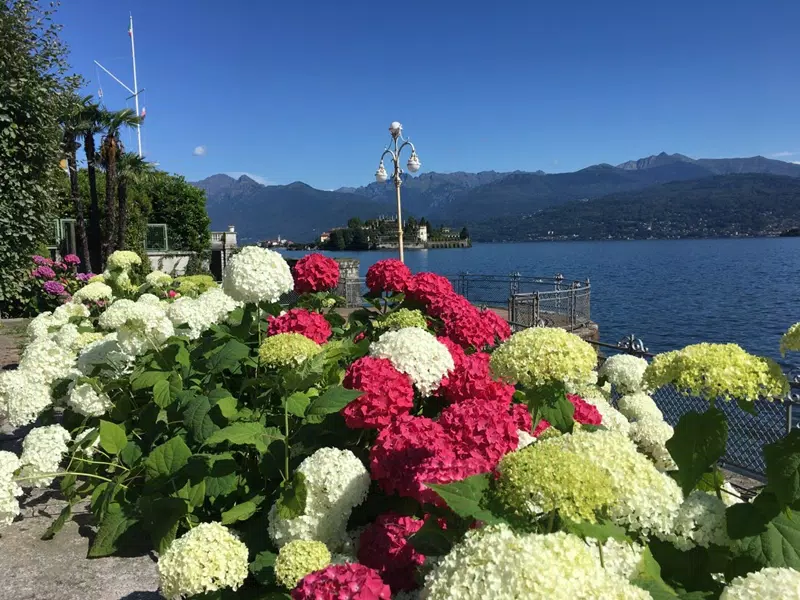 Hydrangea bed by the seaside - Source: pxhere.com; Author: Lake1955; License: CC0 1.0
Hydrangea bed by the seaside - Source: pxhere.com; Author: Lake1955; License: CC0 1.0
Step-by-Step Guide to Planting Hydrangeas
Planting hydrangeas correctly is essential to ensure their healthy growth and the production of vibrant blooms. This guide provides a detailed, step-by-step approach to planting hydrangeas, from preparation to post-planting care.
1. Choose the Right Time to Plant
The optimal times to plant hydrangeas are during the spring or autumn seasons. These periods offer milder temperatures and increased rainfall, which help the plants establish strong root systems before facing the extremes of summer heat or winter cold.
2. Select an Appropriate Location
Hydrangeas thrive best in locations that provide morning sunlight followed by afternoon shade. This exposure protects them from the intense midday sun, reducing the risk of wilting. Additionally, ensure the chosen site has well-draining soil to prevent root rot.
3. Prepare the Soil
Before planting, it's crucial to prepare the soil to meet the hydrangea's needs:
- Test Soil pH: Hydrangeas can adapt to various pH levels, but the soil's pH can influence bloom colour in some species. Acidic soils (pH below 6) tend to produce blue flowers, while alkaline soils (pH above 7) result in pink flowers.
- Enrich the Soil: Incorporate organic matter such as compost or well-rotted manure to enhance soil fertility and structure. This addition improves moisture retention and provides essential nutrients.
4. Submerge the Plant in Water
One of the most critical steps when planting a hydrangea, regardless of the season or weather, is to hydrate the root ball thoroughly. Fill a bucket with water and submerge the entire potted hydrangea into it. Hold the plant under the water until the soil stops bubbling, usually for 1-2 minutes. This process ensures the soil absorbs enough water, preventing the plant from drying out after planting. Proper hydration at this stage significantly increases the chances of the plant thriving.
5. Dig the Planting Hole
The size and depth of the planting hole are vital for the hydrangea's establishment:
- Width: Dig a hole that is twice as wide as the hydrangea's root ball. This width allows the roots to spread easily into the surrounding soil.
- Depth: The hole should be as deep as the root ball, ensuring that the top of the root ball is level with or slightly above the ground surface. Planting too deeply can suffocate the roots, while planting too shallowly can expose them to environmental stress.
6. Position and Plant the Hydrangea
With the hole prepared and the plant hydrated, proceed with planting:
- Position the Plant: Place the hydrangea in the centre of the hole, ensuring the top of the root ball is level with or slightly above the ground surface.
- Backfill the Hole: Fill the hole with the excavated soil, mixed with compost if not already done. As you backfill, gently firm the soil around the root ball to eliminate air pockets, which can dry out roots.
- Press the Soil: Use your hands or feet to press the soil around the base of the plant firmly. This ensures the roots have full contact with the surrounding soil, promoting stability and moisture absorption.
- Water Thoroughly: After planting, water the hydrangea generously to settle the soil and hydrate the plant fully.
7. Apply Mulch
Mulching offers several benefits for newly planted hydrangeas:
- Moisture Retention: A 2-3 inch layer of organic mulch, such as shredded bark or pine needles, helps retain soil moisture, reducing the frequency of watering.
- Temperature Regulation: Mulch helps regulate soil temperature, protecting the hydrangea's roots from extreme heat or cold.
- Weed Suppression: A thick layer of mulch minimises weed growth, reducing competition for nutrients and water.
8. Post-Planting Care
After planting, proper care is essential to help the hydrangea establish itself:
- Watering: Regularly water the plant, especially during the first few weeks after planting. Ensure the soil remains consistently moist but not waterlogged.
- Monitoring: Check for signs of stress, such as wilting or discoloured leaves, and adjust care practices accordingly.
- Support: If the hydrangea is exposed to strong winds or has heavy blooms, consider staking the plant to provide extra support.
Planting hydrangeas correctly ensures their successful establishment and long-term health. By following these detailed steps, including proper hydration, soil preparation, and post-planting care, you can create the ideal conditions for your hydrangeas to thrive and reward you with their stunning blooms for years to come.
Personal Note from the Garden
When I planted my very first hydrangea - a vibrant Hydrangea macrophylla - I was so excited that I skipped a few key steps. I didn’t soak the root ball beforehand, and I underestimated how quickly the sun would dry out the soil. Within days, the leaves started to droop, and the blooms lost their colour. I remember panicking and diving into research to fix it. Since then, I always submerge the plant in water for at least a minute before planting, and I never skip mulching. That simple change made all the difference - the next year, the same plant burst into rich blue blooms and healthy new growth. It's a small habit, but now a golden rule in my planting process.
That simple change made all the difference - the next year, the same plant burst into rich blue blooms and healthy new growth.
It's a small habit, but now a golden rule in my planting process.
If you're just starting out, don’t worry - everyone makes mistakes. Learn more about
common hydrangea planting mistakes and how to fix them.
Watering Hydrangeas: Best Practices for Thriving Plants
Proper watering is crucial for the health and vitality of hydrangeas. This guide explores the optimal watering techniques, frequency, and considerations to ensure your hydrangeas flourish with vibrant blooms.
Understanding Hydrangea Water Needs
Hydrangeas are known for their high water requirements, especially during their active growing season. Ensuring consistent moisture levels is key to preventing stress and promoting healthy growth.
Optimal Watering Techniques
Employing the correct watering methods can significantly impact the well-being of your hydrangeas:
- Deep Watering: Water deeply to encourage extensive root systems. This involves soaking the soil to a depth of at least 6 inches, ensuring roots receive adequate moisture.
- Base Watering: Direct water to the base of the plant, avoiding foliage. Wet leaves can lead to fungal diseases, so it's best to keep them dry during watering.
- Morning Watering: Water hydrangeas in the early morning. This timing allows leaves to dry throughout the day, reducing the risk of mould and mildew.
Determining Watering Frequency
The frequency of watering depends on various factors, including climate, soil type, and plant maturity:
- Newly Planted Hydrangeas: Water 2-3 times per week to help establish roots.
- Established Plants: Provide approximately 1 inch of water per week, either from rainfall or supplemental watering.
- Hot and Dry Conditions: Increase watering frequency during periods of extreme heat or drought to maintain consistent soil moisture.
Soil Considerations
Soil type plays a significant role in determining watering needs:
- Well-Draining Soils: Sandy or loamy soils drain quickly and may require more frequent watering to maintain moisture levels.
- Clay Soils: These retain moisture longer but can become waterlogged. Ensure proper drainage to prevent root rot.
- Mulching: Applying a 2-3 inch layer of organic mulch helps retain soil moisture and regulate temperature, reducing the need for frequent watering.
Signs of Improper Watering
Monitoring your hydrangeas for signs of over or under-watering is essential:
- Under-Watering: Symptoms include wilting, dry or crispy leaf edges, and stunted growth.
- Over-Watering: Look for yellowing leaves, root rot, and a general decline in plant health.
Adjust your watering practices accordingly if you observe these signs.
Additional Tips for Effective Watering
Consider the following to optimise your watering routine:
- Use Soaker Hoses or Drip Irrigation: These methods deliver water directly to the root zone, minimising evaporation and keeping foliage dry.
- Avoid Overhead Sprinklers: They can wet the foliage, increasing the risk of fungal diseases.
- Monitor Weather Conditions: Adjust watering based on rainfall and temperature fluctuations to maintain consistent soil moisture.
Proper watering is fundamental to the health and beauty of your hydrangeas. By understanding their water needs, employing optimal watering techniques, and monitoring soil conditions, you can ensure your hydrangeas thrive and grace your garden with their stunning blooms.
Fertilising Hydrangeas: Best Practices for Vibrant Blooms
Proper fertilisation is crucial for the health and vitality of hydrangeas. This guide explores optimal fertilising techniques, timing, and considerations to ensure your hydrangeas flourish with vibrant blooms.
Understanding Hydrangea Nutrient Needs
Hydrangeas require a balanced supply of nutrients to thrive. The primary macronutrients essential for their growth include:
- Nitrogen (N): Promotes healthy leaf and stem growth.
- Phosphorus (P): Supports root development and enhances flowering.
- Potassium (K): Aids in overall plant health and disease resistance.
Choosing the Right Fertiliser
Selecting an appropriate fertiliser is vital for meeting the specific needs of hydrangeas:
- Balanced Fertilisers: Products with equal ratios of N-P-K, such as 10-10-10, provide a uniform supply of essential nutrients.
- Slow-Release Fertilisers: These formulations release nutrients gradually, ensuring a steady supply over time and reducing the risk of over-fertilisation.
- Organic Options: Compost or well-rotted manure enriches the soil naturally, improving its structure and fertility.
Timing of Fertilisation
The timing of fertiliser application significantly impacts hydrangea health:
- Early Spring: Apply a balanced, slow-release fertiliser as new growth begins to support leaf and stem development.
- Mid-Summer: For varieties that bloom on new wood, a second application can promote continued blooming.
- Avoid Late Season Fertilisation: Refrain from fertilising in late summer or autumn to prevent new growth that may not harden off before winter.
Application Techniques
Proper application ensures nutrients are effectively absorbed:
- Granular Fertilisers: Spread evenly around the base of the plant, avoiding direct contact with stems. Water thoroughly after application to help nutrients penetrate the soil.
- Liquid Fertilisers: Dilute according to manufacturer instructions and apply directly to the soil around the plant's base.
- Organic Amendments: Incorporate compost or manure into the top layer of soil, taking care not to disturb the roots.
Soil pH and Bloom Colour
The pH level of the soil influences the colour of hydrangea blooms:
- Acidic Soils (pH below 6): Tend to produce blue flowers due to increased aluminium availability.
- Alkaline Soils (pH above 7): Result in pink flowers as aluminium becomes less available.
Adjusting soil pH can alter bloom colour, but such changes may take time and should be approached cautiously.
Signs of Nutrient Deficiency
Monitoring hydrangeas for nutrient deficiencies is essential:
- Yellowing Leaves: May indicate nitrogen deficiency.
- Poor Blooming: Could be a sign of insufficient phosphorus.
- Weak Stems: Might suggest a lack of potassium.
Address deficiencies promptly with appropriate fertilisation to maintain plant health.
Proper fertilisation is fundamental to the health and beauty of your hydrangeas. By understanding their nutrient needs, selecting suitable fertilisers, and applying them at the right times, you can ensure your hydrangeas thrive and grace your garden with their stunning blooms.
Pruning Hydrangeas: Timing and Techniques for Optimal Growth
Proper pruning is essential for maintaining the health and beauty of hydrangeas. This guide delves into the optimal timing and methods for pruning, emphasising the importance of spring pruning after the risk of frost has passed.
Understanding the Importance of Pruning
Pruning hydrangeas serves several vital purposes:
- Encourages Vigorous Growth: Removing old or weak stems promotes the development of strong, healthy branches.
- Enhances Bloom Production: Proper pruning can lead to more abundant and larger flowers.
- Maintains Plant Shape: Regular pruning helps in shaping the plant, ensuring a neat and attractive appearance.
Optimal Timing for Pruning
Contrary to some beliefs, the best time to prune hydrangeas is in the spring, after the danger of frost has passed, typically around March. Pruning in autumn is discouraged because:
- Risk of Frost Damage: Pruning in autumn can expose the plant to frost damage, as cuts may not heal before winter, making the plant susceptible to cold injury.
- Loss of Protective Growth: Leaving the plant unpruned during winter allows it to retain old growth, which can protect against harsh weather conditions.
By waiting until spring, any winter damage becomes evident, and pruning can be done effectively to remove affected areas.
Pruning Techniques Based on Hydrangea Types
Different hydrangea species require specific pruning methods:
- Hydrangea macrophylla (Bigleaf): These bloom on old wood. In spring, remove dead or weak stems and cut back to a pair of healthy buds. Avoid heavy pruning to preserve flower buds.
- Hydrangea paniculata (Panicle) and Hydrangea arborescens (Smooth): These bloom on new wood. Prune in late winter or early spring before new growth begins, cutting back stems to encourage vigorous growth.
- Hydrangea quercifolia (Oakleaf): Prune immediately after flowering in summer, as they bloom on old wood. Remove dead or damaged stems and shape the plant as needed.
General Pruning Tips
To ensure effective pruning:
- Use Sharp, Clean Tools: Sharp pruners make clean cuts, reducing the risk of disease.
- Remove Dead or Diseased Wood: Always eliminate unhealthy stems to promote overall plant health.
- Avoid Over-Pruning: Excessive pruning can reduce blooming potential. Focus on removing only what is necessary.
Pruning hydrangeas at the appropriate time and using correct techniques is crucial for their health and blooming potential. By conducting pruning in the spring after the risk of frost has passed, you allow the plant to recover from any winter damage and set the stage for a season of beautiful blooms.
Pest and Disease Management in Hydrangeas: Ensuring Healthy Growth
Hydrangeas are cherished for their stunning blooms and lush foliage. However, they can be susceptible to various pests and diseases. This guide provides detailed information on identifying, preventing, and treating common issues to maintain the health and beauty of your hydrangeas.
Common Pests Affecting Hydrangeas
Several pests can pose challenges to hydrangeas. Understanding their characteristics and control methods is essential for effective management.
Aphids
Identification: Small, soft-bodied insects, often green or black, found on new growth and undersides of leaves.
Damage: They suck sap, causing distorted leaves and excrete honeydew, leading to sooty mould development.
Control:
- Wash aphids off with a strong stream of water.
- Apply insecticidal soap or neem oil to affected areas.
- Encourage natural predators like ladybirds and lacewings.
Spider Mites
Identification: Tiny, spider-like pests often found on the undersides of leaves, causing a stippled or speckled appearance.
Damage: Mites feed on sap, leading to leaf discolouration, drying, and eventual leaf drop.
Control:
- Regularly hose down plants to remove mites and their webs.
- Apply horticultural oils or miticides in severe infestations.
- Maintain adequate humidity levels to discourage mite activity.
Slugs and Snails
Identification: Slime trails and chewed leaves with irregular holes are common signs.
Damage: These pests feed on young leaves and stems, particularly in damp conditions.
Control:
- Use organic bait or traps to capture slugs and snails.
- Place barriers like copper tape around plants.
- Remove hiding spots like mulch or debris near the base of the plant.
Common Diseases Affecting Hydrangeas
Hydrangeas can also suffer from a variety of diseases, often caused by fungal or bacterial pathogens.
Powdery Mildew
Identification: White, powdery spots on leaves, stems, and flowers, often appearing in humid conditions.
Damage: Infected leaves may curl, yellow, and fall prematurely, weakening the plant.
Control:
- Ensure proper air circulation by spacing plants adequately.
- Avoid overhead watering to keep foliage dry.
- Apply fungicides specifically designed for powdery mildew.
Leaf Spot
Identification: Brown or purple spots on leaves, which may enlarge over time, causing leaves to yellow and drop.
Damage: Severe infections can lead to defoliation and reduced flowering.
Control:
- Remove and destroy infected leaves promptly.
- Avoid overhead watering and water at the base of the plant.
- Use copper-based fungicides as a preventative measure.
Root Rot
Identification: Wilting, yellowing leaves, and blackened, mushy roots often caused by poorly draining soil.
Damage: Root rot severely limits the plant's ability to absorb water and nutrients, often leading to plant death.
Control:
- Ensure well-draining soil when planting.
- Avoid overwatering and standing water around the base of the plant.
- Remove and replace severely infected plants to prevent spread.
Preventative Measures
Prevention is the best strategy for managing pests and diseases:
- Regular Monitoring: Inspect plants frequently to catch early signs of issues.
- Healthy Practices: Maintain optimal growing conditions, including proper watering, fertilising, and pruning.
- Cleanliness: Remove fallen leaves and debris to reduce the risk of pests and diseases overwintering.
- Companion Planting: Use pest-repellent plants like marigolds or herbs to deter insects naturally.
Effective pest and disease management ensures hydrangeas remain healthy and beautiful. By identifying common problems early and implementing preventive and corrective measures, you can enjoy vibrant blooms and lush foliage season after season.
Frequently Asked Questions (FAQ)
1. When is the best time to take hydrangea cuttings?
The ideal time depends on the type: softwood cuttings are best taken in late spring or early summer, while hardwood cuttings are suitable for late autumn to early winter.
2. How long does it take for hydrangea cuttings to root?
Softwood cuttings usually root in 4–6 weeks, while hardwood cuttings can take several months to establish roots.
3. Can hydrangeas be propagated in water?
Yes, some gardeners have success propagating hydrangeas in water, but soil-based propagation generally has a higher success rate and encourages stronger root development.
4. What is the easiest hydrangea to propagate?
Hydrangea macrophylla (Bigleaf) and Hydrangea arborescens (Smooth) are among the easiest to propagate using stem cuttings.
5. How can I prevent cuttings from rotting?
Use a sterile, well-draining soil mix, avoid overwatering, and ensure good air circulation around the cuttings.
6. When can I move my propagated hydrangea into the garden?
Once a healthy root system has developed (typically 2–3 months), transplant in spring or early autumn for the best results.
7. Can I propagate hydrangeas from leaf cuttings?
Hydrangeas do not propagate well from leaf cuttings alone. It's best to use stem cuttings with at least one node.
8. How do I know if my cutting has rooted?
Gently tug on the cutting after a few weeks. If there’s resistance and you see new leaf growth, it’s likely rooted.
9. Can I use rooting hormone when propagating hydrangeas?
Yes, rooting hormone can increase the success rate by stimulating faster root development, especially with hardwood cuttings.
10. What’s the difference between softwood and hardwood cuttings?
Softwood cuttings are taken from fresh, green growth in spring or early summer, while hardwood cuttings are from mature, woody stems in autumn or winter.
11. Do I need a greenhouse to propagate hydrangeas?
No, but keeping humidity high (with a plastic dome or bag) and consistent temperatures around 18–22°C helps boost success.
12. Should I cut the flowers off when propagating?
Yes, remove any flowers or buds. The plant needs to focus energy on root development, not blooms.
13. How deep should I plant hydrangea cuttings?
Insert the cutting so that at least one node (where leaves were) is below the soil surface—around 5–7 cm deep is ideal.
14. Can I propagate hydrangeas indoors during winter?
Yes, hardwood cuttings can root indoors if provided with indirect light and stable humidity levels, but growth is slower.
15. Is it better to propagate hydrangeas in pots or directly in the ground?
Pots offer more control over soil and moisture, making them ideal for propagation. Once established, transplant to the garden.
Hydrangeas are versatile and rewarding plants that thrive with proper care.
To stay on top of seasonal tasks, refer to our
Hydrangea Care Calendar for a month-by-month checklist.
About the Author

Richard Seres-Nagy is a passionate gardener with over 20 years of experience in hydrangea care. He founded Hydrangea Library to share expert advice, step-by-step guides, and practical tips for fellow gardening enthusiasts.
Read More
